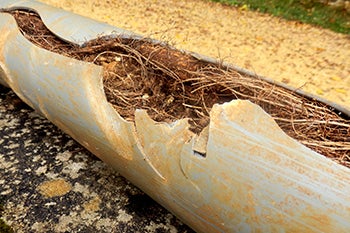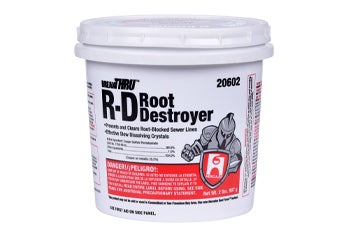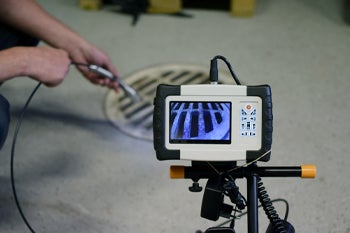Roots can be one of the most damaging problems to discover in a sewer system. Thankfully, there are ways to get rid of roots in sewer pipes.
Roots grow in sewer lines because pipes are well-ventilated and provide an excellent water source. While that's great for plants and trees, it can have a devastating impact on a sewer system.
Roots can block sewer lines and affect the sewer system's hydraulic capacity; i.e., its ability to maintain or pass a given flow rate. A clogged sewer pipe will lead to slow-working drains, unpleasant odors caused by standing water within the drain line, and damaging overflows.
How do roots grow in sewer pipes?
In old clay sewer lines, drain sections were connected by inserting a non-bell spigot end of the pipe into the hub of the next section and filling the gap with concrete. With time, the concrete deteriorates, and roots grow through the openings and expand, damaging the piping.
Roots can also grow through a partially collapsed pipe or even rotted-out cast iron. Deteriorated concrete or rotted-out cast iron is inevitable over time, allowing roots to grow through the openings.

If left untreated, root intrusion can eventually lead to a complete collapse of the sewer system. The roots on the outside of the pipe will encapsulate the pipe, creating pressure that will cause the sanitary system to collapse and shut down. At that point, the last resort would be to dig up the sewer line, costing thousands of dollars depending on location.
Let’s take a look at the five ways to get rid of roots in sewer pipes.
1. First mechanically remove the root
We highly recommend hiring a professional drain cleaning service or plumber to help you get rid of roots in your sewer pipes. Once you or your contractor identifies severe root activity within a sewer line, the roots should be removed with a mechanical, root-removal tool.
You can use cutters, nozzles, cable machines and jetters for severe blockages. Snaking the line with a root cutter is one of the most common ways to remove roots. But be sure the heads and bits used on the ends are specifically designed for cutting out roots. Some heads can expand to adjust to the exact inside diameter of the pipe, completely cutting the roots down to the inside face of the pipe.
This function is particularly helpful. Many cutting tools will leave two inches of roots at the top because they do not fill the entire inside diameter of the pipe.
Keep the following in mind when snaking the line with root cutters:
- Proper cable size: If you don't use the right cable size, you could either damage the tool or cause an injury. Say, for instance, you use a smaller snake. It could get caught in the roots, and you're left with a 20-foot cable stuck in the line. An improperly sized cable could get wound up or could even whip back, potentially leading to an injury.
- Proper head size: As noted above, if you use the wrong head size, you won't get a full cleaning of the inside diameter of the pipe. Sizing is based on the pipe diameter. Most sewer lines will be three to four inches, but the main sewer line could be larger in commercial applications. A standard rule of thumb is to use a cable at least ¾ inch to an inch in diameter.
- Maintaining mechanical equipment: Maintenance is key. If the root cutting head is dull or damaged, it won't be as effective.
This also applies to snake cables. If a cable is kinked or bent, it could bind up and become ineffective because it has a weakened point. It could even break off and get stuck in the sewer or — worse yet — cause injuries.
2. Use a sewer jet to remove piled-up root pieces
Sewer jetting is another common practice for root removal. Jetters consist of a high-pressure water pump, water tank, hose reel, and ½-inch to 1-inch sewer cleaning hose. A sewer jetter is a great tool to remove piled-up root debris that remained in the pipe after using a root cutter.
3. Use a chemical after removing the roots to prevent it from happening again
Chemicals are best used as a preventive maintenance tool after mechanically removing roots from the sewer line. They open, clear, and prevent root-clogged drains and sewer lines.
It's important to understand that while chemical treatments will kill roots and prevent them from growing if used consistently, they won't immediately solve the problem. First, you have to mechanically clear the blocking to ensure that chemicals can effectively flow through the sewer line and adhere to the root mass.
Chemical treatments to consider:
● Hercules® R-D™ Root Destroyer is a special flake-like formula that prevents and stops root growth in external drain lines. Because this formula interacts with water, the drain line will need to be mechanically opened (snaked) to allow water flow if it is completely blocked.
Once the line is open, the solution can be poured into your toilet and flushed. Adding a treatment before bedtime will allow the Root Destroyer to work overnight without being flushed out too soon. Follow manufacturer directions for application and use. You can purchase Hercules Root Destroyer at your local hardware store.
How to use Hercules® R-D™ Root Destroyer:
- Use two to four pounds in a single application. Pour R-D into a toilet bowl closest to the sewer line (1/2lb.) at a time and flush after each 1/2 lb. to be sure all crystals will be carried to the sewer line.
- Another option is to remove the clean out plug (usually located outside or in your basement) and pour the entire package directly into the sewer line. Flush it into the sewer with water. Note: Never pour R-D into sink or tub drains.

- Use two pounds of R-D twice each year, and use the same method as described above for partial stoppages. To avoid wasting R-D by flushing it through a largely unobstructed sewer, apply it in the evening before retiring or during other low flow periods for best results. Even small hair roots will absorb the chemical, preventing later blockage problems.
4. Consider installing cured-in-place pipe lining
Pipelining offers an alternative solution to avoid digging up a damaged sewer line caused by root intrusion.
A cured-in-place pipe (CIPP) is a trenchless rehabilitation method used to repair existing pipelines. A cured-in-place epoxy liner is applied to the inside of the pipe. Once fully cured, the lining acts as a new pipeline, sealing any opening or gaps to stop leaks and prevent future root intrusion.
5. Finally, have your sewer line inspected every two years to identify a root problem
Be sure to have your sewer line inspected every two years, especially if you've had issues in the past. Hire a plumber or a drain-cleaning or sewer service company to 'scope' the line and identify any problems.
Scoping involves sending a remote camera down the line for a visual inspection. Depending on the findings, the company will recommend jetting or a drain cleaner to clear the line of any root growth.
